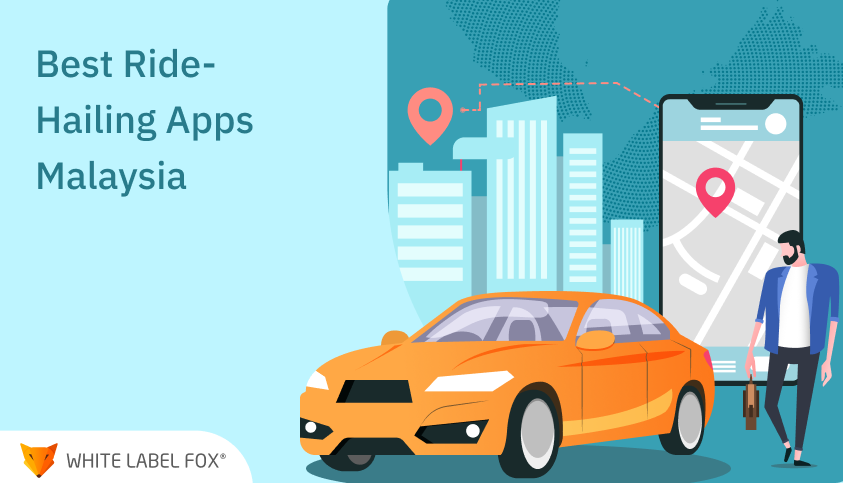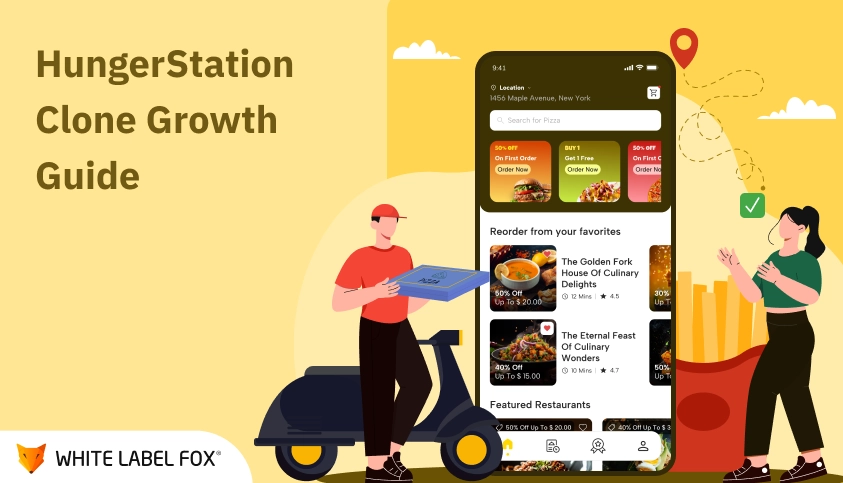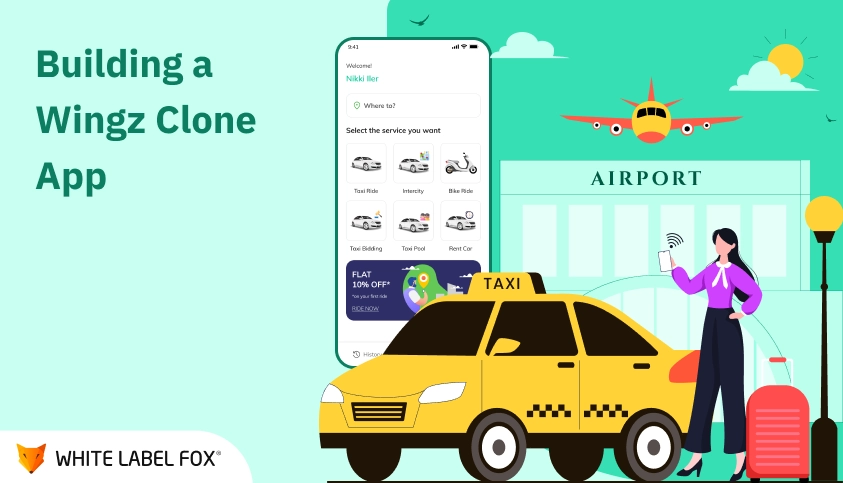In a world where “comfort” is the king and hunger waits for one, Domino’s has revolutionized how we satisfy our quench for pizza. The company has been making headlines since its launch and now has become a “go-to” place for all pizza lovers. Along with scrumptious taste lies in cheesy creation, there is a robust business model that has made the company successful and a name at the global level.
Do You Want To Launch A Food Delivery App Like Domino's For Your Business?
Connect With Our Experts And Discuss Your Ideas.
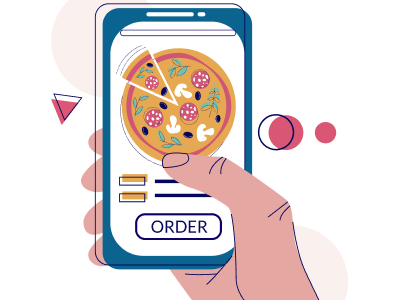
Domino’s is not just making pizzas; it’s delivering a masterclass in how to grow in the saturated and competitive landscape of the fast food industry.
Launched as a humble pizza parlour in a small town, Domino’s has now become a global pizza powerhouse and this is the reason why more and more entrepreneurs want to get insight into Domino’s business and revenue model. From implementing technological innovations to online delivery to kiosks, Domino’s has created a blueprint for businesses seeking to enter this field.
Want to know more? Let’s join us, exploring its business model and its secret sauce that makes Domino’s a global player in no time.
An Overview of Domino’s
A chain of pizza restaurants called Domino’s Pizza Inc. (Domino’s). Through its eateries, it offers dine-in and online pizza delivery services as well.
Customers of Domino’s can choose from a large selection of pizza products with different crusts and sizes. It also provides a variety of toppings according to nation and culture.
The company operates in the US and other international markets, such as India, the UK, Japan, Mexico, Australia, China, and France, through a network of company-owned and franchised stores. The US city of Ann Arbor, Michigan, is home to Domino’s headquarters.
Indeed, Domino’s is a popular pizza chain delivery restaurant and has come so far by implementing unique marketing strategies, technological innovations and much more.
Domino’s Exciting Facts and Timeline
| Brand Name | Domino’s Pizza |
| Founders | James Monaghan |
| Established In | 1960 |
| Legal Name | Domino’s Pizza |
| Industry | Fast Food, Franchising |
| Employees | 13,500 |
| Revenue | US$4.357 billion (as of 2021) |
| Number of Locations | 18,848 |
| Area Served | Worldwide |
| Website | https://dominos.com/ |
Now without wasting any time, let’s have a look at the detailed timeline of Domino’s along with some interesting facts and figures.
- In Ypsilanti, Michigan, “DomiNick’s,” a pizzeria, was bought by Tom Monaghan and his brother James in 1960, marking the beginning of it.
- In the year 1965, Tom Monaghan bought two additional pizza eateries and now had three locations in the same country.
- In 1967, Domino’s Pizza launched as a franchise,
- By 1978, it had grown to 200 locations.
- In Winnipeg, Manitoba, Canada, on May 12, 1983, Domino’s launched its first international location.
- The chain’s first location in the UK opened in Luton in 1985.
- Domino’s had grown to over 1,000 foreign outlets by 1995.
- Domino’s inaugurated its 1,500th overseas site in 1997
- By 2014, the company had grown to 6,000 outlets worldwide.
- In India, Domino’s opened its 1,000th location in February 2016.
- As of October 2019, Domino’s Pizza China operated over 250 locations in nine cities.
- More than 90% of orders are placed online in China.
- Domino’s started trading common stock on the New York Stock Exchange in 2004 under the ticker “DPZ”.
- In January 2006, Domino’s celebrated the opening of its 5,000th American store in Huntley, Illinois.
- After two years of falling sales due to COVID-19 lockdowns in Italy.
Currently, Domino’s Pizza stands as one of the biggest pizza franchises globally, with over 17,000 outlets throughout more than 90 countries. The company’s success may be ascribed to both its dedication to quality and client happiness and its creative approach to pizza delivery.
How Does Domino’s Operate?
We usually see Domino’s franchise store whenever we roam around the streets. But as we discussed earlier, Domino’s is also ahead in the technological game and implemented an online ordering system for its operation. This dual approach satisfies the unique needs of customers and ensures immense accessibility.
Domino’s Online Operations Online Ordering
Customers can use the official Domino’s website or mobile app to place online orders. As a guest, they can place an order or register.
Menu Options
Online clients peruse the interactive menu, choose their desired foods, and then personalize their orders by adding extra toppings, crust variations, and side dishes.
Delivery versus Takeout
Clients can choose to have their orders delivered or to be picked up from the closest Domino’s store at a specified location.
Payment Details and Address
Online users safely enter their delivery addresses and payment details using the website or mobile application.
Tracking in Real Time
Domino’s provides its online clients with a “Pizza Tracker” tool that lets them see the development of their order in real-time, from preparation to
Confirmation and Delivery
Customers receive confirmation data after placing an online purchase, and delivery drivers are sent to the designated area to deliver the food.
Review and Ratings
Domino’s Online welcomes evaluations and comments from clients, which aids in the company’s efforts to raise the calibre and standard of its offerings.
This is how online pizza ordering from Domino’s works. In offline operations, customers need to visit nearby Domino’s stores, check the menu, and place an order. Moreover, some stores also have a kiosk where customers can place orders themselves and wait for their turn to collect the food.
Domino’s Business Model
Domino’s has a simplified business strategy that focuses on two main avenues: franchised stores and online pizza sales.
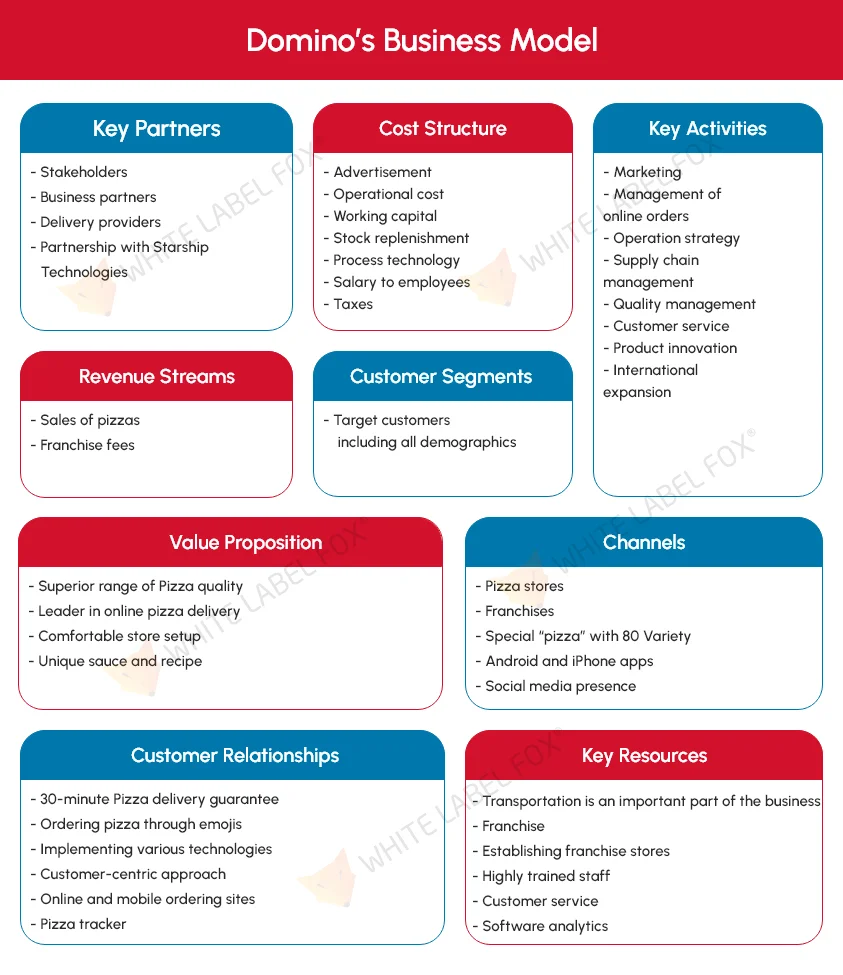
Customer Segments
Domino’s serves a large customer base across the globe, having a presence in more than 90+ countries and selling approx. three million pizzas every day. Shocking right? Yes, it is.
The company’s major customer segments comprise:
- Individual customers across various demographics and income levels always look out for quick and cost-effective food offerings.
- Groups and families, comprising families with kids
- Event planners, comprising customers arranging large events for occasions or businesses
Domino’s is based in the USA but serves a worldwide customer base. But the interesting fact is it has numerous stores in India with large customer base.
Value Proposition
Domino’s offers value to its patrons in several ways:
- Digital ordering: Capitalizing on the desire of most American adults for online pizza ordering, Domino’s offers online ordering through a dedicated app and website. The company guarantees prompt delivery with exclusive offers.
- Globalization: With operations in over 85 markets across the Americas, Africa, the Middle East, and Asia, Domino’s offers a broad reach and accessibility to its renowned pizza offerings.
- Order accessibility and ease: Customers may simply place orders over the phone, using an app, or in-store, tailoring their experience to their tastes.
- Effective Supply Chain Management: Domino’s is proud of its integrated supply chain and flour manufacturing system, which ensures consistency and quality of products offered throughout its franchise locations.
Channels
Domino’s offers customers various channels to place online pizza orders and receive their food at their doorsteps. Below are the main channels Domino’s is using right now.
- Online Ordering: Domino’s allows customers the convenience of online ordering, allowing them to customise their toppings and meals before placing an order.
- Quick and Real-time Tracking: Domino’s application comes with various useful features and allows customers to track their orders in real-time in an efficient manner.
- Advertising: Domino’s use various online and offline marketing channels to create a brand image and spread the word about their brand.
- Customer Support: Domino’s provides customers with a helpline to seek assistance and make inquiries related to their orders.
This is how Domino’s works and establishes a win-win situation for all the stakeholders included.
How Does Domino’s Make Money?
Selling pizzas to customers and other related items is the key revenue source of the company. The main source of income for Domino’s is selling pizza online and offline, which brings the major revenue to the table. This offers a variety of pizzas with various sizes, toppings and beverages.
Other revenue sources include a delivery fee and franchise fees.
2020 saw royalties and fees overtake company-owned outlets as the US segment’s primary revenue sources. The corporation’s sales in the US sector amounted to $1.45 billion. The company’s US segment saw a net gain in revenue of about $179 million. The table below shows the net revenue breakdown for the company’s US segment for the years 2019 and 2020.
Revenue at US company-owned stores increased by $32 million, or 7.1%, in 2020 compared to the year before. The main causes of the revenue rise were an improvement in same-store sales and an increase of $10.6 million in the 53rd week. Company-owned same-store sales increased by 11% in 2020.
Conclusive Thoughts
To sum up, Domino’s business model approach combines digital supremacy, astute pricing, inventive product development, successful advertising, and tactical alliances delightfully. They have been able to hold onto their status as the world’s leading pizza company because of this formula for success. Strong ties have been maintained between Domino’s and its franchisees in the US, Canada, and other international markets.
Furthermore, Domino’s business model is a winning combination of a wide menu, ease of use, worldwide reach, clever alliances, inventiveness, and a pleasurable dine-in experience. The next time you enjoy a slice of Pizza, keep in mind that the company has developed a well-thought-out business model that has been refined over time to provide customers with not just delicious food but also an unforgettable experience.
If you are thinking of entering the food delivery business, get started with a feature-rich online ordering system and take your business online. After all, who doesn’t like to earn a name like Domino’s? We, all right?
Frequently Ask Questions
Domino’s business model revolves around providing high-quality pizza
and
other food items through a mix of direct sales via company-owned
stores,
franchises, and delivery services. It focuses on quick service,
digital
ordering, and innovative delivery options like contactless delivery,
to
enhance customer experience and operational efficiency.
Domino’s business model includes several revenue streams:
- Product Sales: Income from pizza, pasta, sandwiches,
and
drinks sold at stores.
- Franchise Royalties: Fees from franchisees, both
initial
and ongoing.
- Delivery Services: Fees associated with delivery
orders
placed online or via the app.
- Merchandising: Revenue from branded items and
cross-promotional activities.
- Advertising and Co-Branding: Income from marketing
collaborations and promotional deals.
- Product Sales: Income from pizza, pasta, sandwiches, and drinks sold at stores.
- Franchise Royalties: Fees from franchisees, both initial and ongoing.
- Delivery Services: Fees associated with delivery orders placed online or via the app.
- Merchandising: Revenue from branded items and cross-promotional activities.
- Advertising and Co-Branding: Income from marketing collaborations and promotional deals.
Domino’s operates through both company-owned and franchised stores.
Franchisees pay initial franchise fees and ongoing royalties based
on
their sales. This business model allows Domino’s to rapidly expand
its
global presence while minimizing capital expenditure. Franchisees
are
responsible for day-to-day operations while benefiting from Domino’s
brand recognition and support.
Technology plays a crucial role in Domino’s business strategy. The
company invests heavily in:
- Digital Ordering Platforms: Websites, mobile apps,
and
third-party platforms for seamless customer ordering.
- Advanced Delivery Tracking: Real-time GPS tracking to
improve delivery efficiency.
- Automation: Use of machines for pizza preparation,
reducing labor costs and improving consistency.
- AI and Analytics: For optimizing delivery routes,
customer engagement, and inventory management.
- Digital Ordering Platforms: Websites, mobile apps, and third-party platforms for seamless customer ordering.
- Advanced Delivery Tracking: Real-time GPS tracking to improve delivery efficiency.
- Automation: Use of machines for pizza preparation, reducing labor costs and improving consistency.
- AI and Analytics: For optimizing delivery routes, customer engagement, and inventory management.
Domino’s has heavily invested in digital platforms for ordering and
delivery. This includes:
- Mobile Apps: Allowing customers to place orders,
track
deliveries, and customize orders.
- Online Ordering: Enabling customers to place orders
through their website and other e-commerce platforms.
- Third-Party Platforms: Collaborations with apps like
UberEats or DoorDash to expand reach and offer more
convenience.
These channels contribute significantly to Domino’s overall
sales growth.
- Mobile Apps: Allowing customers to place orders, track deliveries, and customize orders.
- Online Ordering: Enabling customers to place orders through their website and other e-commerce platforms.
- Third-Party Platforms: Collaborations with apps like UberEats or DoorDash to expand reach and offer more convenience. These channels contribute significantly to Domino’s overall sales growth.
Delivery is a major component of Domino’s revenue. The company
offers
various delivery options, including:
- In-House Delivery: Delivery drivers employed by
Domino’s
deliver pizza directly to customers.
- Third-Party Delivery Partnerships: Collaborations
with
services like UberEats or DoorDash for wider delivery reach.
Delivery service charges and tips are key revenue streams in
this area, contributing substantially to Domino’s growth.
- In-House Delivery: Delivery drivers employed by Domino’s deliver pizza directly to customers.
- Third-Party Delivery Partnerships: Collaborations with services like UberEats or DoorDash for wider delivery reach. Delivery service charges and tips are key revenue streams in this area, contributing substantially to Domino’s growth.
Domino’s employs a competitive pricing strategy, offering affordable
meal options that appeal to a wide range of customers. The company
also
uses promotional deals like "two-for-one" offers, discounts, and
value
meal bundles to attract more customers. Pricing flexibility and
frequent
deals help boost sales and maintain customer loyalty.
Key advantages of Domino’s business model include:
- Franchise Growth: Expanding rapidly without taking on
the
full operational burden.
- Technological Innovation: Embracing technology for
better
customer engagement and operational efficiency.
- Brand Recognition: Leveraging a globally recognized
brand
for both marketing and franchise success.
- Scalability: Ability to easily scale operations
through
franchising and technology.
- Franchise Growth: Expanding rapidly without taking on the full operational burden.
- Technological Innovation: Embracing technology for better customer engagement and operational efficiency.
- Brand Recognition: Leveraging a globally recognized brand for both marketing and franchise success.
- Scalability: Ability to easily scale operations through franchising and technology.
Domino’s focuses on customer loyalty through:
- Rewards Programs: Offering discounts and deals for
repeat
customers.
- Customer Experience: Ensuring fast, reliable delivery
and
consistent quality.
- Personalization: Tailoring offers and promotions
based on
customer preferences and order history.
- Digital Engagement: Through apps and online
platforms,
providing a seamless and rewarding customer experience.
- Rewards Programs: Offering discounts and deals for repeat customers.
- Customer Experience: Ensuring fast, reliable delivery and consistent quality.
- Personalization: Tailoring offers and promotions based on customer preferences and order history.
- Digital Engagement: Through apps and online platforms, providing a seamless and rewarding customer experience.


